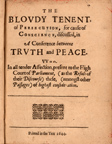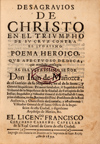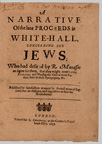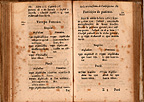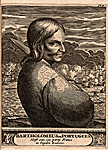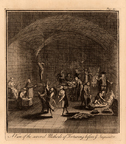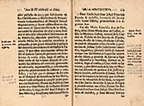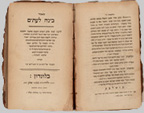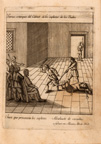From Intolerance to Emancipation Spaniards from the late fifteenth century regarded themselves as holy reformers, bringing about a uniformity of religious observance in what had been a multifaith society under Islamic rule.In more tolerant Portugal, uncoverted Jews were ordered to be expelled in 1496, and an Inquisition was established in 1540. When Spain attained a dual monarchy with Portugal (1580-1640), new conditions developed. The Inquisition in Spain, Portugal, and the colonies pursued suspicions that conversos or New Christians were practicing secret Judaism or retaining a spiritual identification. These investigations were often sporadic, depending on neighbors to report on suspicious behavior. At the same time, Spanish culture harbored a deep veneration for the ancient Israelites of the Old Testament as the precursors of Christianity, and prized Hebrew as a “Holy Language.” Juxtaposed with Inquisition material in this section are documents from other parts of Europe illustrating more tolerant attitudes that would in time be realized as elements of the Rights of Man. |
||
|
|
||
|
30. Inquisition. Peru. Auto de la fe celebrado en Lima a 23. de enero de 1639. Lima: Pedro de Cabrera, 1639. |
|||
31. Inquisition. Mexico. Relacion svmaria del avto particvlar de fee… celebro en la muy noble, y muy real Ciudad de Mexico a las diez y seis del mes de abril del año de mil y seiscientos y cuaranta y seis. Mexico City: Francisco Robleda, [1646]. |
|||
| 32. Francisco Corchero Carreno. Desagravios de Christo en el trivmpho de su cruz contra el judaismo. Poema heroico. Mexico: Juan Ruiz, 1649. Cast in poetic form, this represents one of the strongest attacks by ecclesiastical authors on Judaism and the Jews, and is an important testimony of anti-semitic attitudes in the Spanish colonies. The pamphlet does not limit itself to attacking Jews, but also goes after Martin Luther and the “dogmatists.” |
|||
33. Henry Jessey. A narrative of the late proceeds at White-Hall, concerning the Jevvs: who had desired by R. Manasses an agent for them, that they might return into England. London: L. Chapman, 1656. |
|||
| 34. Martín del Castillo. Arte hebraispano. : [Dikduk leschon hakkodhesch bilschon sipharadhith.] Grammatica de la lengua santa en idioma castellan. Lyon: for Florian Anisson, 1676. This grammar for Spanish readers is testimony of interest in Hebrew, “the holy language” in imperial Spain, and is the first book on the language written by a resident of the American continent. In his preface, the Franciscan author cites other landmark Spanish publications that had presented the Greek and Arabic languages to the Hispanic world. The pages shown here offer a sample of the third conjugation for preterite (past tense) and the present participle. The gift of Ruth S. Goldberg, Leo M. Goldberg & Gertrude Harris, Robert J. Selig, Herbert H. Goldberger, Robert M. Siff, Myer Saxe, Theodore I. Libby, & Frederick Bloom. |
|||
| 35. Alexandre Olivier Exquemelin. De Americaensche zee-roovers. Amsterdam: Jan ten Hoorn, 1678. This is the first edition of the essential pirate book that formed the foundation for many of the histories and romances of the buccaneers published during the seventeenth and eighteenth centuries. Alexandre Exquemelin served as a doctor with the French West India Company and saw active duty in the Caribbean in the 1660s and early 1670s where he came into contact with various privateers. It is likely that persecution and exclusion from commercial life in Latin America may have driven some Jews to a life on the fringes of legal commerce. A journalist from Jamaica has recently made an effort to identify some of the known cast of pirates and buccaneers as Jewish in heritage. Focusing in particular on records in Port Royal, he has documented such figures as [Moses Cohen] Henriques and Bartholomew the Portuguese, who play a major role in the Exquemelin narrative. |
|||
| 36. Rev. J. Baker. A complete history of the Inquisition in Portugal, Spain, Italy, the East and West-Indies, in all its branches, from the origin of it in the year 1163, to its present state. Westminster, London: O. Payne, 1736. Reverend Baker launches one of the first full-scale official British attacks against the Spanish and Portuguese Inquisition, which he defines as “diabolical.” Vivid illustrations portray articles of clothing used for public humiliation and some of the instruments of torture used to extract confessions from those believed to have strayed from Catholic doctrine into the active practice of Judaism and other beliefs. |
|||
| 37. Pedro José Bermúdez de la Torre y Solier. Triunfos del Santo Oficio Peruano. Relacion panegyrica, historica, y politica del auto publico de fè. Lima: Imprenta Real, 1737. Among other cases, this work details that of the last Jew in Lima “to be sentenced and die at the stake.” “Maria Francisca Ana de Castro, alias Dona Maria Ana de Castro, alias la Madama Castro, natural de la ciudad de Toledo en los Reynos de Espana, vezina de esta de Lima, de estado Casada, de edad de cinquenta anos, de casta y generacion de Judios, Judia Judaizante….” |
|||
| 38. John Locke. A letter concerning toleration. Boston : Rogers and Fowle, 1743. This is the third American edition of Locke’s plea for religious toleration, which had a very substantial effect on the Founding Fathers and on the developing religious policy of the newly founded United States. Locke wrote at length about the history of the Jews, and about the restrictions governments have placed on religious minorities, when those groups justly deserve liberty: “Neither Pagan, nor Mahumetan, nor Jew, ought to be excluded from the Civil Rights of the Commonwealth, because of his Religion.” He viewed Quakers, Anabaptists, and others in the same light. |
|||
| 39. Jean Baptiste Sanchamau. L'école des peuples et des rois, ou Essai philosophique sur la liberté, le pouvoir arbitraire, les juifs et les noirs. Paris: Chez Letellier, libraire, 1790. In the revolutionary fervor of the late eighteenth century, this French writer addressed the necessity of granting liberty both to Jews and enslaved Africans, referring to the role of George Washington and the activism of Quaker abolitionists and the Abolition Society in Boston. He remained convinced, however, that emancipation of the slaves should be an incremental process, or severe social unrest might erupt. |
|||
| 40. Jacob Hart. [`Asarah maamarot : milhamot H. ... Binah le-`itim ... Tsuf novlot]. [London: David bar Mordekhai ha-Levi, 1794-1799]. This work is a vigorous defense of Judaism against the rationalist theories of Voltaire, Paine, and others. The author—sometimes identified as Eliakim ben Abraham or Elyakim ben Avraham—has been described as the first native-born English Jew who possessed a level of religious learning comparable to that of his fellow Jews on the continent. Hart’s second work, [Bina l’Itim], addresses the cryptic chronology in the Book of Daniel and the predicted coming of the Messiah in the year 1840, and contains a reference to America. In the realm of Messianic speculation, Hart concludes “Know that the year 1783 was indeed the End of Days. In that year peace and freedom was declared for the inhabitants of America. From there that light of freedom spread and reached France. It continues to light up the world, urging the world to end its abominations.” Acquired with the assistance of the Littauer and Harper Funds. |
|||
| 41. Zvi Hirsch Mailfeld. [Divrei negidim]. [Amsterdam : Solomon Proops, 1799]. This work contains scattered references to Jews in America. One passage concerns the deliberations by the Dutch Parliament in 1796 over granting full rights to Jews, considering the fact that such freedom had already been granted to Jews in America and France, where the action was seen as a positive development for those societies. Purchased with the assistance of a donation from J. Allen "Jack" Jager, M.D., in memory of Beryl Fiering, grandfather of Norman Fiering, and Beryl's sister Gittel Fiering Yager, grandmother of Jack Yager. With additional assistance from the Bloomingdale and Littauer Funds. |
|||
| 42. Juan López Cancelada. Decreto de Napoleon emperador de los franceses, sobre los judios residentes en Francia. Mexico: Mariano de Zúniga y Ontiveros, 1807. While celebrating Napoleon’s act of emancipation for Jews in France, the author notes as well the dark processes of interrogation by the Spanish Inquisition, and the harsh and unusual punishments delivered for other crimes and moral lapses. |
|||
| 43. Narrative of the proceedings of the Jews, in their attempt to establish their right to the elective franchise in Jamaica.Belfast: A. MacKay, Jun., 1823. The author notes that while a wide range of opinion exists between different Christian denominations without affecting citizenship rights, those same rights are denied “the unfortunate Jew, whose mind is perhaps equally enlightened with that of the more fortunate Christian.” Citing the writings of John Locke and Thomas Jefferson on toleration, he suggests that similar rights to those of Virginia (The Virginia Statute on Religious Freedom) should be granted elsewhere in the world. |
|||
| 44. Great Britian. Colonial Office. Return to an Address of the Honourable the House of Commons, dated 24 June 1831; -- for, copies of the laws passed by the several colonial legislatures, for the relief of the Catholics, the removal of the disabilities of the Jews, and of free persons of colour. [London?, 1832]. Included here are laws passed by the colonial legislatures of Antigua, Barbados, Bahamas, Dominica, Grenada, S. Kitts, Virgin Islands and Tortola, St. Vincent, and Tobago. These laws established the rights of Jews, Catholics, and free Africans in the British West Indies. Jamaica soon followed the other islands. |
|||
Exhibition prepared by Dennis Landis, Curator of European Books.



